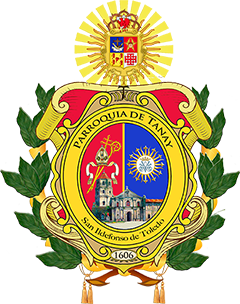TANAY AND ITS CHURCH: A Historical Sketch

From 1573 to 1582 two Franciscan missionaries, Fr. Juan de Plasencia and Fr. Diego de Oropesa traveled and established missions in lakeshore towns and villages along the north coast of Laguna de Bay, also known as Lake of Bai, as well as the nearby mountain villages of Sierra Madre. It was at this time that Pilang-Morong as Pililla was then called was made a “visita” or barrio of Morong town. Several communities of the un-baptized, called “rancherias” by the Spaniards, were placed under Pililla, among them Monte Tan-ay whose leader was Don Francisco Casag.
Pililla separated from Morong in 1583 and became an independent town and parish and Monte Tan-ay was made a “visita” under the jurisdiction of Pililla.
In turn, Monte Tan-ay separated from Pililla in 1606 and was made an independent parish, San Ildefonso de Toledo, by popular choice, became its patron saint with Fray Pedro de Talavera as first parish priest until 1608. It was also in 1606 that he founded the mission of San Antonio in Pantay.
The town was subsequently transferred to San Antonio (The second site of Tanay) in 1620 without changing its patron saint. Shortly after, its church made of wood and cogon grass for its roof was burned down by hostile Aetas by means of flaming arrows. According to church records, only a very old image of La Purisima Concepcion (painted by the Spanish painter, Murillo) was saved. It was believed to have been left in haste by the retreating Spanish forces of Captain Juan de Salcedo that were defeated and driven back by the natives of Monte Tan-ay that they came to subdue in 1572.
In 1639 a very serious Chinese uprising erupted in La Laguna and spread to Manila and Bulacan. When government forces subdued the uprising, a very big remnant of Chinese rebels in flight numbering around 13,700 arrived in the mountain of Tanay and established their camps in Monte Tan-ay (now called Inalsan) and Pantay (Tanay’s second site). Fearing that the Chinese might harm the image, the Franciscan parish priest, Fr. Geronimo de Frias, hid the La Purisima Concepcion inside the jungle nearby. When the combined Spanish-Filipino forces discovered where those Chinese were encamped, they made a very well-planned attack, had their first engagement with the Chinese on January 23, 1640, and Monte Tan-ay or Inalsan fell. The Chinese garrisoned at Pantay became so alarmed so that the following day, January 24, 1640 they left in haste after placing the town to the torch. The town people fled, then dispersed and most of them took refuge in Pililla. In the same year, Fr. Geronimo de Frias and Fr. Diego de San Yldefonso urged them to regroup and with their consent decided then and there to transfer the town of Tanay to its present site although some families opted to remain in Inalsan and Pantay to continue their livelihood there. So they came down in 1640 and established the town of Tanay and parish of San Ildefonso de Toledo in the present site.
Tradition has it that three of the fleeing Chinese soldiers unwittingly discovered the image of La Purisima Concepcion that was hidden in the jungle. Two of them threw their spears at the image but these miraculously turned around at the throwers and killed them both. The third soldier who witnessed this event became so terrified that he committed suicide by hanging himself from a tree, on account of which, the place is still called Binitinan or Pinagbigtihan (Place of Hanging) to this day. This story is attested to not only in tradition but is also recorded or accounted in the church annals of the Franciscans in the Philippines.
In memory of that event, a feast in honor of the Blessed Virgin Mary was celebrated the following year on January 24, 1641, the day after the feast day of San Ildefonso de Toledo, the patron saint on January 23, and onwards up to the present, year after year, after year.
For 38 years or so, the people of Tanay suffered their church to be made of bamboo and cogon grass for roofing. But in 1678 at their insistence, Fr. Pedro de Espallargas initiated the building of a stone church like the one in Pililla which was built in 1673 and is still in use. This first stone church in Tanay faced east, occupying a large part of what is now Tanay Park. This was completed in 1680 largely through the donations by the people so deeply devoted to the Purisima Concepcion and the first mass was celebrated on April 20, 1680.

The present church was started in 1773 through the initiative of Fr. Alonso de Fentanes and the people of Tanay because the old church which was completed in 1680 was already greatly damaged due to natural calamities such as typhoons and strong earthquakes. It was completed in 1783 while the 6 retablos in honor of Nuestra Señora de las Angustias, of La Purisima Concepcion, of San Josef, of San Pedro de Alcantara, of the Baptism of our Lord and of San Ildefonso de Toledo, more popularly called the retablo mayor were finished in 1785 and installed the following year, 1786.
Towards the end of 1999 our church was declared as one of the five Jubilee Churches in the Diocese of Antipolo. It was honored us such when the Papal Nuncio to the Philippines, Most Rev. Antonio Franco visited and prayed inside the church on June 22, of the Jubilee Year 2000.
Another great honor was endowed our church when, on July 31, 2001 it was declared a National Cultural Treasure by the National Museum of the Philippines along with 25 other churches all over the Philippines.


